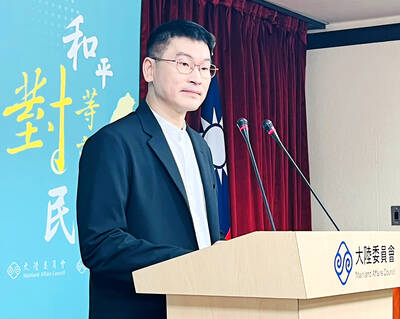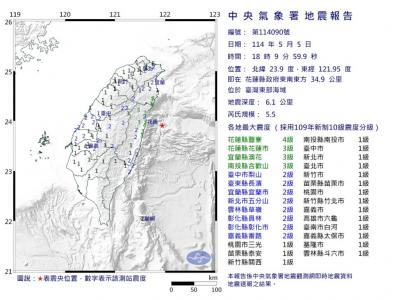The government is closely monitoring a flurry of construction work by rival claimant nations in South China Sea islands and reefs, National Security Bureau (NSB) Director-General Lee Shying-jow (李翔宙) said, although he disagreed with calls to bolster Taiwan’s military built-up in the disputed region.
Lee was asked about reports about Vietnam deploying heavy artillery guns and other enhanced military installations on the Spratly Islands (Nansha Islands, 南沙群島) by Chinese Nationalist Party (KMT) Legislator Lin Yu-fang (林郁方) at a session of the legislature’s Foreign Affairs and National Defense Committee yesterday.
“In the South China Sea, for any country undertaking efforts to strengthen their defense and to project a stronger military presence, it is not a good thing for the stability of that region,” the bureau head said.
According to Lin, Vietnam has been active in the area, undertaking construction and installing heavy artillery weapons on Sandy Cay (Duncian Shajou, 敦謙沙洲) and Namyit Island (Hongsiou Island, 鴻庥島).
Lin said that Sandy Cay lies just 6 nautical miles (11.11km) from Itu Aba Island (Taiping Island, 太平島), which is Taiwan’s largest territory in the South China Sea.
Lin urged the government to renew construction on extending the airstrip on Itu Aba Island to accommodate C-130 military transport aircraft.
“The runway extension will enable us to conduct marine rescue operations and disaster relief missions,” Lin said.
“When carried out, these can reduce tension in the region and can help to enhance Taiwan’s good image in the international community,” Lin added.
However, Lee backed away from endorsing plans to continue the runway extension work.
“Besides competition, we should consider cooperation in the international arena,” Lee said.
“If we boost our military installation on Taiping Island, it might harm the nation’s situation in the region,” Lee said.
“It is also not conducive to regional stability in the South China Sea,” Lee added.
Regarding Vietnam’s new military facilities and construction work on the Spratly Islands, Lee said the bureau is aware of the situation and has it under close monitoring.
Taiwan’s intelligence agency and armed forces are also closely following stepped-up construction and land reclamation activities by China in the region, including on Fiery Cross Reef (Yongshu Reef, 永暑礁), Johnson South Reef (Chigua Reef, 赤瓜礁), Hughes Reef (Dongmen Reef, 東門礁), Cuarteron Reef (Huayang Reef, 華陽礁) and Gaven Reef (Nansyun Reef, 南薰礁).
Meanwhile, Lee confirmed that the Democratic Progressive Party’s (DPP) official Web site had been shut down on Tuesday due to a series of DDoS (distributed denial of service) attacks from outside Taiwan.
Although Lee would not give more details, DPP legislators said the 100,000 hostile attacks within a five-minute period came from bases in China.
DPP officials said they have reported the hacking attacks to the police and urged authorities to find ways to protect the nation’s digital networking security.
During the committee session yesterday, the NSB head said that the agency would establish a cybersecurity department in May and would staff the unit with professionals from the private sector.
The new department would comprise four divisions staffed by people who are trained to fight cybercrime, Lee said, adding that they would not be hackers.
Certain amendments to the nation’s information and communications regulations would be required to recruit cybersecurity and computer network experts from the private sector, Lee said.
The bureau would also seek to facilitate exchange programs with foreign cybersecurity communities to upgrade the skills of the unit’s staff, he said.
Additional reporting by CNA

An essay competition jointly organized by a local writing society and a publisher affiliated with the Chinese Communist Party (CCP) might have contravened the Act Governing Relations Between the People of the Taiwan Area and the Mainland Area (臺灣地區與大陸地區人民關係條例), the Mainland Affairs Council (MAC) said on Thursday. “In this case, the partner organization is clearly an agency under the CCP’s Fujian Provincial Committee,” MAC Deputy Minister and spokesperson Liang Wen-chieh (梁文傑) said at a news briefing in Taipei. “It also involves bringing Taiwanese students to China with all-expenses-paid arrangements to attend award ceremonies and camps,” Liang said. Those two “characteristics” are typically sufficient

A magnitude 5.9 earthquake that struck about 33km off the coast of Hualien City was the "main shock" in a series of quakes in the area, with aftershocks expected over the next three days, the Central Weather Administration (CWA) said yesterday. Prior to the magnitude 5.9 quake shaking most of Taiwan at 6:53pm yesterday, six other earthquakes stronger than a magnitude of 4, starting with a magnitude 5.5 quake at 6:09pm, occurred in the area. CWA Seismological Center Director Wu Chien-fu (吳健富) confirmed that the quakes were all part of the same series and that the magnitude 5.5 temblor was

The brilliant blue waters, thick foliage and bucolic atmosphere on this seemingly idyllic archipelago deep in the Pacific Ocean belie the key role it now plays in a titanic geopolitical struggle. Palau is again on the front line as China, and the US and its allies prepare their forces in an intensifying contest for control over the Asia-Pacific region. The democratic nation of just 17,000 people hosts US-controlled airstrips and soon-to-be-completed radar installations that the US military describes as “critical” to monitoring vast swathes of water and airspace. It is also a key piece of the second island chain, a string of

The Central Weather Administration has issued a heat alert for southeastern Taiwan, warning of temperatures as high as 36°C today, while alerting some coastal areas of strong winds later in the day. Kaohsiung’s Neimen District (內門) and Pingtung County’s Neipu Township (內埔) are under an orange heat alert, which warns of temperatures as high as 36°C for three consecutive days, the CWA said, citing southwest winds. The heat would also extend to Tainan’s Nansi (楠西) and Yujing (玉井) districts, as well as Pingtung’s Gaoshu (高樹), Yanpu (鹽埔) and Majia (瑪家) townships, it said, forecasting highs of up to 36°C in those areas